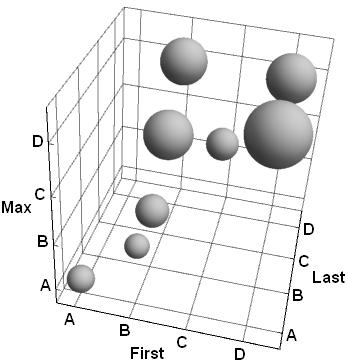3D-FLM (First, Last, Max): A Novel Summative Measure of Hepatocellular Carcinoma (HCC) Tumor Burden Predicts HCC Recurrence After Liver Transplantation (LT).
1Univ. Colorado, Aurora
2UCSF, San Francisco.
Meeting: 2016 American Transplant Congress
Abstract number: A183
Keywords: Allocation, Hepatocellular carcinoma, Liver transplantation, Tumor recurrence
Session Information
Session Name: Poster Session A: Liver - Hepatocellular Carcinoma and Cholangiocarcinoma Malignancies
Session Type: Poster Session
Date: Saturday, June 11, 2016
Session Time: 5:30pm-7:30pm
 Presentation Time: 5:30pm-7:30pm
Presentation Time: 5:30pm-7:30pm
Location: Halls C&D
Risk of recurrent HCC post-LT depends on tumor aggressiveness, pre-LT HCC burden and treatment response while waiting for LT. Standard measures of pre-LT HCC burden lack a time component. AIM: To develop an objective measure of HCC burden incorporating biologic behavior and treatment response over time. METHODS: Using UNOS Region 8 data from 2002-2014, we identified LT recipients with HCC (any stage) and verified in text narratives, HCC sizes, alpha fetoprotein (AFP) and treatments over the waitlist period. HCC burden by Size and AFP were characterized using 3 time coordinates: First, Last, and Max (at time of max HCC diameter). Classes were Size A:<Milan, B: Milan, C: >Milan to UCSF, D: >UCSF; and 1: AFP<500, 2: 500-999, 3:1000-4999, 4: ≥5000. The 3D-FLM coordinates were assessed for association with HCC recurrence (by detail review of malignancy follow-up data) using chi-squared tests. RESULTS: Of 1110 LT recipients, 62% had any pre-LT HCC treatment and 7% (n=79) had post-LT recurrent HCC with median (IQR) follow up of 2.6 years (1.0-5.0). HCC burden by size (A,B,C,D) and AFP (1, 2, 3, 4) classes was significantly associated with post-LT HCC recurrence at each individual time point (First, Last, Max), p<0.05. Correlation between UNOS data and Region 8 text narratives was moderate (weighted Kappa=0.57). When HCC burden by Size was plotted in 3D FLM time coordinates (First, Last, Max), HCC recurrence was high (25-50%) in FLM-Size classes DDD, DBD, BDD, BCC and low (<10%) when Milan criteria was never exceeded i.e FLM-Size classes AAA, ABB, BBB. FIGURE: shows % with post-LT HCC recurrence (shown as bubble volume) by FLM-Size coordinates. Similarly, using AFP, post-LT HCC recurrence was high (25-100%) in FLM-AFP classes 313, 223, 122 and low (<10%) when AFP never exceeded 500 i.e FLM-AFP class 111 only. Both the FLM-Size and FLM-AFP models were strongly associated with post-LT recurrent HCC (p≤0.01). CONCLUSION: The 3D-FLM model can characterize pre-LT HCC tumor burden over time, predict post-LT HCC recurrence and may be a useful as tool for assessing LT candidates with HCC. 
CITATION INFORMATION: Nordstrom E, Dodge J, Gralla J, Campbell K, Palmer C, Biggins S. 3D-FLM (First, Last, Max): A Novel Summative Measure of Hepatocellular Carcinoma (HCC) Tumor Burden Predicts HCC Recurrence After Liver Transplantation (LT). Am J Transplant. 2016;16 (suppl 3).
To cite this abstract in AMA style:
Nordstrom E, Dodge J, Gralla J, Campbell K, Palmer C, Biggins S. 3D-FLM (First, Last, Max): A Novel Summative Measure of Hepatocellular Carcinoma (HCC) Tumor Burden Predicts HCC Recurrence After Liver Transplantation (LT). [abstract]. Am J Transplant. 2016; 16 (suppl 3). https://atcmeetingabstracts.com/abstract/3d-flm-first-last-max-a-novel-summative-measure-of-hepatocellular-carcinoma-hcc-tumor-burden-predicts-hcc-recurrence-after-liver-transplantation-lt/. Accessed December 28, 2025.« Back to 2016 American Transplant Congress
